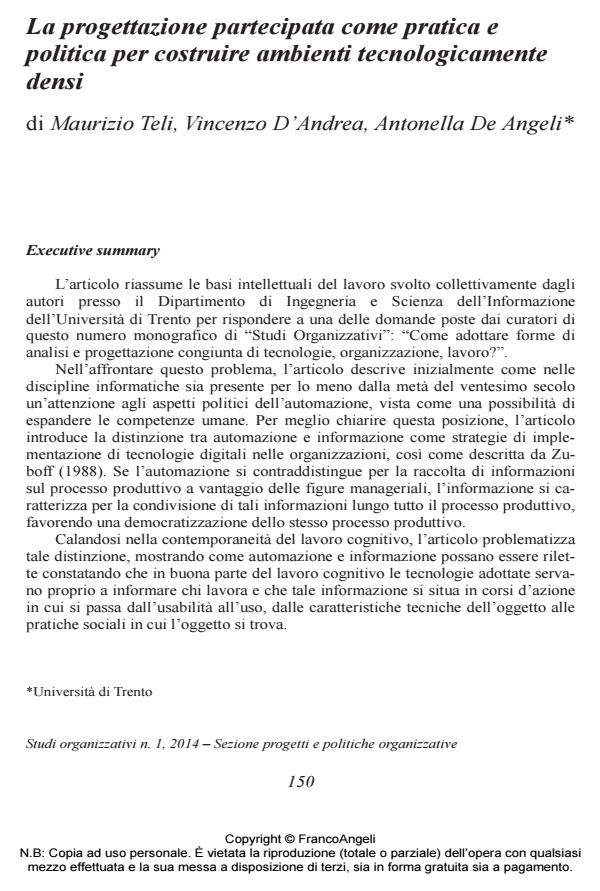La progettazione partecipata come pratica e politica per costruire ambienti tecnologicamente densi
Journal title STUDI ORGANIZZATIVI
Author/s Maurizio Teli, Vincenzo D'Andrea, Antonella De Angeli
Publishing Year 2014 Issue 2014/1
Language Italian Pages 13 P. 150-162 File size 61 KB
DOI 10.3280/SO2014-001007
DOI is like a bar code for intellectual property: to have more infomation
click here
Below, you can see the article first page
If you want to buy this article in PDF format, you can do it, following the instructions to buy download credits

FrancoAngeli is member of Publishers International Linking Association, Inc (PILA), a not-for-profit association which run the CrossRef service enabling links to and from online scholarly content.
Starting with Wiener’s political program in the field of informatics, oriented toward enhancing human capabilities, this paper sketches the research agenda of the authors as designers of digital technologies. Drawing upon Zuboff’s analysis of the use of digital technologies in organizations, that distinguish between automating, more hierarchically oriented, and informating, more democratically oriented, the article discuss the concepts in the light of the transformation of the way of working, nicely captured by the focus on knowledge work and on technologically dense environments. In such a context, Scandinavian Participatory Design is introduced, as a way of designing technologies that privileges the situated use value for workers. Through the direct participation of users in the design of technological artefacts, Participatory Design is able to rebalance some of the power relations related to the use of technology. his is shown through the case of the Smart Campus project, that confirms the ability of users participation to reshape power relations. In conclusion, the article defines as future research goals the ones related to the understanding of the potential for users participation in Italy outside the university context.
Keywords: Automation, information, participatory design, university, politics
- Perceived autonomy and discretion of mobile workers Roberto Albano, Ylenia Curzi, Tania Parisi, Lia Tirabeni, in STUDI ORGANIZZATIVI 2/2019 pp.31
DOI: 10.3280/SO2018-002002 - Assessing the technological maturity of small enterprises through a collaborative approach Andrea Tomo, in STUDI ORGANIZZATIVI 2/2019 pp.147
DOI: 10.3280/SO2018-002007
Maurizio Teli, Vincenzo D'Andrea, Antonella De Angeli, La progettazione partecipata come pratica e politica per costruire ambienti tecnologicamente densi in "STUDI ORGANIZZATIVI " 1/2014, pp 150-162, DOI: 10.3280/SO2014-001007